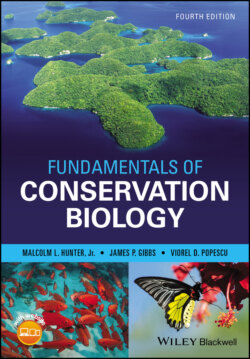Читать книгу Fundamentals of Conservation Biology - Malcolm L. Hunter Jr. - Страница 96
Polymorphism
ОглавлениеPolymorphism (usually abbreviated P) is defined as the proportion or percentage of genes that are polymorphic. A gene is considered polymorphic if the frequency of the most common allele is less than a defined threshold (usually 95%, Hartl and Clark 1997); otherwise it is monomorphic, that is, lacking in variation. This definition is easier to explain with numbers than with words; we will use data collected from five American bison sampled from the descendants of bison that were moved to Badlands National Park as part of a reintroduction program (McClenaghan et al. 1990). The allelic distributions for 24 different genes were determined using electrophoresis of blood proteins, and only one gene was polymorphic. That is, for the other 23 genes sampled, a single allele accounted for at least 95% of the samples. The polymorphic gene was called malate dehydrogenase‐1 (abbreviated MDH‐1) for the enzyme it encoded. MDH‐1 had two different alleles that we will call X and Y. Among the five bison, two individuals (A and B) were heterozygous (X/Y), two individuals (C and D) were homozygous for the Y allele (Y/Y), and one (E) was homozygous for the X allele (X/X) (Table 5.1). In this case Y was the most common allele; its frequency was 0.6 or 60% (i.e. 6 of the 10 alleles were Y), and the frequency of the X allele was 0.4. Because the frequency of the most common allele, Y, was 60% and so less than 95%, the MDH‐1 gene was considered polymorphic. Because out of the 24 genes sampled, only MDH‐1 was polymorphic, the estimated polymorphism was 1 divided by 24 or 0.042 or 4.2%.
Table 5.1 Distribution of two alleles, MDH‐1 x and MDH‐1 y , among five bison.
Source: Based on McClenaghan et al. 1990.
| Bison | X allele | Y allele | Genotype |
|---|---|---|---|
| A | 1 | 1 | X/Y |
| B | 1 | 1 | X/Y |
| C | 0 | 2 | Y/Y |
| D | 0 | 2 | Y/Y |
| E | 2 | 0 | X/X |
| Total | 4 | 6 | |
| Gene frequency | 0.4 | 0.6 |
Although it is common for a single allele to comprise close to 100% of any gene that is not polymorphic, very few genes consist of absolutely 100% of a single allele. If you search a large enough sample of individuals, you are likely to find rare alleles. Rare alleles are defined as having a frequency of less than 0.005, 0.01, or 0.05, depending on the techniques employed and how the information is being used. Most of these rare alleles linger in populations but have no fitness advantages for individuals that possess them. However, these rare alleles can suddenly become the grist for evolutionary change, that is, they represent the latent variation in populations that becomes valuable when the environment changes. Turning back to the gray squirrel (see Fig. 5.3), the species was once comprised almost entirely of the darker morph in the old growth forests of North America (so alleles associated with gray coats were rare) (Schorger 1949). Due to selection against the darker morph by hunters and forest destruction following European colonization, the darker morph virtually disappeared. Now the dark morph, and the allele that generates them, are very rare in most populations except urban ones. With hunting declining and urbanization spreading, the now rare allele associated with the darker morph may become more widespread again.
Finally, we need to emphasize that polymorphism is usually based on the distribution of alleles, not genotypes. This means that given a population without any heterozygotes, a gene could still be polymorphic. To return to our bison example, a population of four homozygous Y/Y bison plus one homozygous XIX bison would be polymorphic at this locus, and P would still be 4.2%.
